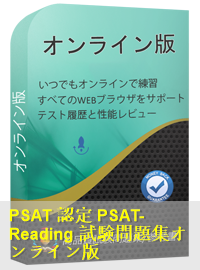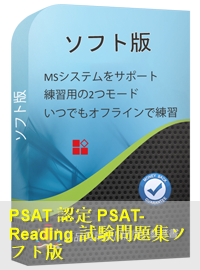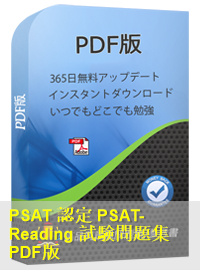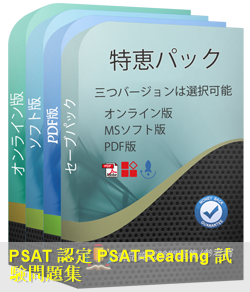GoShiken は PSAT-Reading 試験「Preliminary Scholastic Aptitude Test - Reading」のサンプル問題を無料で提供しています。購入する前、弊社の模擬試験画面や問題のクオリティー、使いやすさを事前に体験できます。
Preliminary Scholastic Aptitude Test - Reading: PSAT-Reading 試験
「Preliminary Scholastic Aptitude Test - Reading」、PSAT-Reading試験であります、PSAT認定でございます。 最適な問題と解答をまとめられて、GoShiken はお客様のPSAT-Reading試験に計 258 問をまとめてご用意いたしました。PSAT-Reading試験の集結内容には、PSAT Certification認定にあるエリアとカテゴリの全てをカバーしており、お客様の Preliminary Scholastic Aptitude Test - Reading 試験認定合格の準備を手助けをお届けします。



リアルなPSAT-Readingテストエンジン
弊社のPreliminary Scholastic Aptitude Test - Reading受験資料はお客様がPSAT PSAT-Reading試験を受けるために必要なすべてのものが含まれています。詳細はPreliminary Scholastic Aptitude Test - Reading認証専門家側が研究して制作されて、彼らは業界の経験を利用して正確で論理的な制品を改良され続けています。
品質と価値のあるPSAT-Reading試験問題
GoShiken練習試験PSAT PSAT-Readingは認定された対象分野の専門家と公開された作成者のみを招いて、最高水準の技術的精度で作成されています。
PSAT-Reading試験合格を100%返金保証
お客様がもしGoShikenのテストエンジンを使って PSAT-Reading 試験「Preliminary Scholastic Aptitude Test - Reading」に不合格されました場合、弊社はお客様に購入金額を全額返金致します。
- PSAT-Reading 試験に関する広範囲的な問題と解答
- PSAT-Reading 試験問題集は事前使用できる
- 問題は業界の専門家によって調査されて、ほぼ100%正解率の検証済みの回答
- PSAT-Reading 試験問題集は定期的に更新されます
- 本番試験を基づいてまとめられた PSAT-Reading 問題集
- こちらの問題集は販売される前に複数回シミュレーション済み
- GoShiken で購入すると決める前に、無料で PSAT-Reading 試験問題集のサンプルを試せます
365日無料アップデート
購入日から365日無料アップデートをご利用いただけます。365日後、PSAT-Reading問題集更新版がほしく続けて50%の割引を与えれます。
インスタントダウンロード
お支払い後、弊社のシステムは、1分以内に購入したPSAT-Reading問題集をあなたのメールボックスにお送りします。 2時間以内に届かない場合に、お問い合わせください。
100%返金保証
購入後60日以内に、PSAT-Reading試験に合格しなかった場合は、全額返金します。 そして、無料で他の試験問題集を入手できます。
ハイパスレート
近年、PSAT-Readingテスト連続は好評を博しており、すべての献身的な努力で99%の合格率に達しています。 より多くの労働者がより高い自己啓発を進めるための強力なツールとして、PSAT-Reading認定トレーニングは高度なパフォーマンスと人間中心の技術への情熱を追求し続けています。 さまざまな種類の受験者がPreliminary Scholastic Aptitude Test - Reading認定を受けるのをどのように手助けするかを理解するために多くの研究が行われてきました。 シラバスの変更および理論と実践における最新の動向に従って、Preliminary Scholastic Aptitude Test - Readingガイドの連続を修正して更新します。 私たちは、厳密な分析を通じて、近年のテストと業界の動向に基づいてPSAT-Reading認定トレーニングを行います。
信頼できる売り上げ後のサービス
最高のPSAT-Readingテスト連続を提供することにおける世界的なリーダーとして、我々は大多数の消費者に包括的なサービスを提供することに専念して、そして統合されたサービスを構築するよう努めます。 さらに、PSAT-Reading認定トレーニングアプリケーション、インタラクティブ共有、アフターサービスでも画期的な成果を上げました。 実際のところ、私たちの会社はすべてのクライアントのフィッティングソリューションに対する困難を考慮に入れています。 あなたが助けを必要とする限り、Preliminary Scholastic Aptitude Test - Readingガイドの連続に関する問題のいずれかに対処するための即時サポートを提供します。 いつでも利用可能です。 私たちの責任あるスタッフが質問に答えてくれます。
PSAT Preliminary Scholastic Aptitude Test - Reading 認定 PSAT-Reading 試験問題:
1. Here my friend, about whose madness I now saw, or fancied that I saw, certain indications of method,
removed the peg which marked the spot where the beetle fell, to a spot about three inches to the
westward of its former position. Taking, now, the tape measure from the nearest point of the trunk to the
peg, as before, and continuing the extension in a straight line to the distance of fifty feet, a spot was
indicated, removed, by several yards, from the point at which we had been digging.
Around the new position a circle, somewhat larger than in the former instance, was now described, and
we again set to work with the spades. I was dreadfully weary, but, scarcely understanding what had
occasioned the change in my thoughts, I felt no longer any great aversion from the labor imposed. I had
become most unaccountably interested--nay, even excited. Perhaps there was something, amid all the
extravagant demeanor of Legrand--some air of forethought, or of deliberation, which impressed me. I dug
eagerly, and now and then caught myself actually looking, with something that very much resembled
expectation, for the fancied treasure, the vision of which had demented my unfortunate companion. At a
period when such vagaries of thought most fully possessed me, and when we had been at work perhaps
an hour and a half, we were again interrupted by the violent howlings of the dog. His uneasiness, in the
first instance, had been, evidently, but the result of playfulness or caprice, but he now assumed a bitter
and serious tone. Upon Jupiter's again attempting to muzzle him, he made furious resistance, and,
leaping into the hole, tore up the mould frantically with his claws. In a few seconds he had uncovered a
mass of human bones, forming two complete skeletons, intermingled with several buttons of metal, and
what appeared to be the dust of decayed woolen. One or two strokes of a spade upturned the blade of a
large Spanish knife, and, as we dug farther, three or four loose pieces of gold and silver coin came to
light.
At sight of these the joy of Jupiter could scarcely be restrained, but the countenance of his master wore an
air of extreme disappointment he urged us, however, to continue our exertions, and the words were hardly
uttered when I stumbled and fell forward, having caught the toe of my boot in a large ring of iron that lay
half buried in the loose earth.
We now worked in earnest, and never did I pass ten minutes of more intense excitement. During his
interval we had fairly unearthed an oblong chest of wood, which, from its perfect preservation and
wonderful hardness, had plainly been subjected to some mineralizing process--perhaps that of the
Bi-chloride of Mercury. This box was three feet and a half long, three feet broad, and two and a half feet
deep. It was firmly secured by bands of wrought iron, riveted, and forming a kind of open trelliswork over
the whole. On each side of the chest, near the top, were three rings of iron--six in all--by means of which a
firm hold could be obtained by six persons. Our utmost united endeavors served only to disturb the coffer
very slightly in its bed. We at once saw the impossibility of removing so great a weight. Luckily, the sole
fastenings of the lid consisted of two sliding bolts. These we drew back trembling and panting with anxiety.
In an instant, a treasure of incalculable value lay gleaming before us. As the rays of the lanterns fell within
the pit, there flashed upwards a glow and a glare, from a confused heap of gold and of jewels, that
absolutely dazzled our eyes. I shall not pretend to describe the feelings with which I gazed. Amazement
was, of course, predominant. Legrand appeared exhausted with excitement, and spoke very few words.
Jupiter's countenance wore, for some minutes, as deadly a pallor as it is possible, in nature of things, for
any negro's visage to assume. He seemed stupefied thunderstricken. Presently he fell upon his knees in
the pit, and, burying his naked arms up to the elbows in gold, let them there remain, as if enjoying the
luxury of a bath.
It became necessary, at last, that I should arouse both master and valet to the expediency of removing the
treasure. It was growing late, and it behooved us to make exertion, that we might get every thing housed
before daylight. It was difficult to say what should be done, and much time was spent in deliberation--so
confused were the ideas of all. We, finally, lightened the box by removing two thirds of its contents, when
we were enabled, with some trouble, to raise it from the hole. The articles taken out were deposited
among the brambles, and the dog left to guard them, with strict orders from Jupiter neither, upon any
pretence, to stir from the spot, nor to open his mouth until our return.
The sentence "Perhaps there was something, amid all the extravagant demeanor of Legrand--some air of
forethought, or of deliberation, which impressed me" (2nd paragraph) is best an example of
A) aside
B) figurative language
C) cause and effect
D) characterization
E) foreshadowing
2. Oliver Goldsmith (17301774) wrote criticism, plays, novels, biographies, travelogues, and nearly every
other conceivable kind of composition. This good-humored essay is from a series published in the Public
Ledger and then in book form as The Citizen of the World (1762).
Were we to estimate the learning of the English by the number of books that are every day published
among them, perhaps no country, not even China itself, could equal them in this particular. I have
reckoned not less than twenty-three new books published in one day, which, upon computation, makes
eight thousand three hundred and ninety-five in one year. Most of these are not confined to one single
science, but embrace the whole circle. History, politics, poetry, mathematics, metaphysics, and the
philosophy of nature, are all comprised in a manual no larger than that in which our children are taught the
letters. If then, we suppose the learned of England to read but an eighth part of the works which daily
come from the press and surely non can pretend to learning upon less easy terms), at this rate every
scholar will read a thousand books in one year. From such a calculation, you may conjecture what an
amazing fund of literature a man must be possessed of, who thus reads three new books every day, not
one of which but contains all the good things that ever were said or written.
And yet I know not how it happens, but the English are not, in reality so learned as would seem from this
calculation. We meet but few who know all arts and sciences to perfection; whether it is that the generality
are incapable of such extensive knowledge, or that the authors of those books are not adequate
instructors. In China, the Emperor himself takes cognizance of all the doctors in the kingdom who profess
authorship. In England, every man may be an author, that can write; for they have by law a liberty, not
only of saying what they please, but of being also as dull as they please.
Yesterday, as I testified to my surprise, to the man in black, where writers could be found in sufficient
number to throw off the books I saw daily crowding from the press. I at first imagined that their learned
seminaries might take this method of instructing the world. But, to obviate this objection, my companion
assured me that the doctors of colleges never wrote, and that some of them had actually forgot their
reading. "But if you desire," continued he, "to see a collection of authors, I fancy I can introduce you to a
club, which assembles every Saturday at seven . . . ." I accepted his invitation; we walked together, and
entered the house some time before the usual hour for the company assembling. My friend took this
opportunity of letting me into the characters of the principal members of the club . . .
"The first person," said he, "of our society is Doctor Nonentity, a metaphysician. Most people think him a
profound scholar, but, as he seldom speaks, I cannot be positive in that particular; he generally spreads
himself before the fire, sucks his pipe, talks little, drinks much, and is reckoned very good company. I'm
told he writes indexes to perfection: he makes essays on the origin of evil, philosophical inquiries upon
any subject, and draws up an answer to any book upon 24 hours' warning . . . ."
The word obviate (paragraph 4) means
A) facilitate
B) clarify
C) negate
D) obscure
E) turn
3. George Washington served as president of the Constitutional Convention in 1787, and was then elected
President of the United States in 1789. This is from his first address to Congress. Such being the
impressions under which I have, in obedience to the public summons, repaired to the present station, it
would be peculiarly improper to omit, in this first official act, my fervent supplications to the Almighty Being,
who rules over the universe, who presides in the councils of nations, and whose providential aids can
supply every human defect, that his benediction may consecrate to the liberties and happiness of the
people of the United States a government instituted by themselves for these essential purposes, and may
enable every instrument employed in its administration to execute with success the functions allotted to
his charge. In tendering this homage to the great Author of every public and private good, I assure myself
that it expresses your sentiments not less than my own; nor those of my fellow-citizens at large, less than
either. No people can be bound to acknowledge and adore the invisible hand, which conducts the affairs
of men, more than the people of the United States.
Every step, by which they have advanced to the character of an independent nation, seems to have been
distinguished by some token of providential agency. And, in the important revolution just accomplished in
the system of their united government, the tranquil deliberations and voluntary consent of so many distinct
communities, from which the event has resulted, cannot be compared with the means by which most
governments have been established, without some return of pious gratitude along with a humble
anticipation of the future blessings which the past seems to presage. These reflections, arising out of the
present crisis, have forced themselves too strongly on my mind to be suppressed. You will join with me, I
trust, in thinking that there are none, under the influence of which the proceedings of a new and free
government can more auspiciously commence.
By the article establishing the executive department, it is made the duty of the President "to recommend
to your consideration such measures as he shall judge necessary and expedient." The circumstances,
under which I now meet you, will acquit me from entering into that subject farther than to refer you to the
great constitutional charter under which we are assembled; and which, in defining your powers,
designates the objects to which your attention is to be given. It will be more consistent with those
circumstances, and far more congenial with the feelings which actuate me, to substitute, in place of a
recommendation of particular measures, the tribute that is due to the talents, the rectitude, and the
patriotism, which adorn the characters selected to devise and adopt them. In these honorable
qualifications I behold the surest pledges, that as, on one side, no local prejudices or attachments, no
separate views or party animosities, will misdirect the comprehensive and equal eye, which ought to
watch over this great assemblage of communities and interests; so, on another, that the foundations of
our national policy will be laid in the pure and immutable principles of private morality, and the
preeminence of a free government be exemplified by all the attributes, which can win the affections of its
citizens, and command the respect of the world.
When Washington says that "in obedience to the public summons" he has "repaired to the present
station," he means that he
A) was haled before this court to testify
B) intends to correct the mistakes of his predecessors
C) has been elected to this office
D) volunteered for his current duties
E) will step down as required by law
4. The spring is fairly with us now. Outside my laboratory window the great chestnut-tree is all covered with
the big, glutinous, gummy buds, some of which have already begun to break into little green shuttlecocks.
As you walk down the lanes you are conscious of the rich, silent forces of nature working all around you.
The wet earth smells fruitful and luscious. Green shoots are peeping out everywhere. The twigs are stiff
with their sap; and the moist, heavy English air is laden with a faintly resinous perfume. Buds in the
hedges, lambs beneath them--everywhere the work of reproduction going forward!
I can see it without, and I can feel it within. We also have our spring when the little arterioles dilate, the
lymph flows in a brisker stream, the glands work harder, winnowing and straining. Every year nature
readjusts the whole machine. I can feel the ferment in my blood at this very moment, and as the cool
sunshine pours through my window I could dance about in it like a gnat. So I should, only that Charles
Sadler would rush upstairs to know what the matter was. Besides, I must remember that I am Professor
Gilroy. An old professor may afford to be natural, but when fortune has given one of the first chairs in the
university to a man of four-and-thirty he must try and act the part consistently.
In context, the word "glutinous" most nearly means?
A) large.
B) fertile.
C) bloated.
D) hungry.
E) sticky.
5. In compliance with the request of a friend of mine, who wrote me from the East, I called on good-natured,
garrulous old Simon Wheeler, and inquired after my friend's friend, Leonidas W. Smiley, as requested to
do, and I hereunto append the result. I have a lurking suspicion that Leonidas W. Smiley is a myth; that
my friend never knew such a personage; and that he only conjectured that, if I asked old Wheeler about
him, it would remind him of his infamous Jim Smiley, and he would go to work and bore me nearly to
death with some infernal reminiscence of him as long and tedious as it should be useless to me. If that
was the design, it certainly succeeded.
I found Simon Wheeler dozing comfortably by the barroom stove of the old, dilapidated tavern in the
ancient mining camp of Angel's, and I noticed that he was fat and bald-headed, and had an expression of
winning gentleness and simplicity upon his tranquil countenance. He roused up and gave me good-day. I
told him a friend of mine had commissioned me to make some inquiries about a cherished companion of
his boyhood named Leonidas W.
Smiley--Rev. Leonidas W. Smiley--a young minister of the Gospel, who he had heard was at one time a
resident of Angel's Camp. I added that, if Mr. Wheeler could tell me anything about this Rev. Leonidas W.
Smiley, I would feel under many obligations to him.
What can we infer about what the author thinks of his friend from the East by the statement, "I have a
lurking suspicion that Leonidas W. Smiley is a myth" 1st paragraph?
A) Smiley will, as a result of his friend referring him, will show him a rousing good time.
B) His friend is mistaken about the existence of Smiley.
C) His friend may be playing a practical joke on him.
D) He believes his friend wants revenge for some earlier misgivings.
E) His friend knows that Smiley and he will strike a friendship.
質問と回答:
| 質問 # 1 正解: C | 質問 # 2 正解: C | 質問 # 3 正解: C | 質問 # 4 正解: E | 質問 # 5 正解: C |
 450 お客様のコメント最新のコメント 「一部の類似なコメント・古いコメントは隠されています」
450 お客様のコメント最新のコメント 「一部の類似なコメント・古いコメントは隠されています」
私は1日4時間を3日で合格できました。(ぎりぎりでしたが……一応合格なので…笑)試験は暗記が勝負のところがあるので、そこは少し手間かもしれません。
過去問でどのくらいの結果が出るか楽しみです。
PSAT-Reading問題を解きながら解説も理解できるので学び易いと思います。
本日、受験し見事満点で合格しました。
本当に助かりました、ありがとうございました。
今後ともよろしくお願い申し上げます。
PSAT-Reading知識も経験も無しにいきなりこの試験から受けるという方はいないでしょう。きっちりと情報がまとまっているし
ソフトとアプリがもらえて、内容も濃く、問題や擬似問題集と回答などもあり
問題や擬似問題集と回答などもあり、PSAT-Reading1冊で試験に対応できる良い本だと思います。高い合格率があります。
PSAT-Readingソフトバージョンをダウンロードできるのも非常にありがたいです。これだけ内容が充実しているのにこの安さは正直驚きです。
優秀なPSAT-Reading問題集です!合格しました。PSAT-Readingの問題集は助けになりました。大変ありがとうございました。
GoShikenおすすめします。分かりやすい言葉で解説されており、力作だと思いますので、使い込みたいと思います。
この参考書で試験勉強をして昨日合格しました。
自宅で一から問題集を勉強して、そして模擬テストに臨みました。
最初は正解率50%ぐらいしかなくて焦りましたが、繰り返し模擬テストを受けることで克服しました。
無事合格できてよかったです。GoShiken様のおかげです。ありがとうございました。
これPSAT-Readingをおさえておけば得点アップにつながることは間違いないっす。また、資格勉強のためだけでなくPSAT-Readingがどんなものか知りたい方にもおすすめできます。
PSAT-Readingの問題集を購入して翌日にGoShikenから最新版を送られて、それげ受験してやっぱり合格だ。
本日、試験を受験し、無事で合格できました。実質4日での合格です。とても嬉しいです。ありがとうございました
PSAT-Reading受験者のためのやさしい参考書&問題集だと思います。GoShikenはいいぞ
確実にPSAT-Reading勉強したいかたにおすすめです。PSAT-Reading試験対策のテキストです。
評判通りの素晴らしい問題集です!使用して無事合格することができました。模擬問題を繰り返し出来るし、自分が何が苦手なのかをはっきり分かって、苦手潰しをした結果、合格に繋がりました!
PSAT-Readingの問題集、理解しやすかったです。口コミどおり、これ問題集一つで合格できるって本当ですね。
GoShikenから提供されたこのPSAT-Reading問題集一つで習得できました。今回は試験に受かりそうです。
PSAT-Readingメインの解説を補足する側注ヒント要素は、解釈でわかりやく内容を明示。つまづきやすいポイントをフォローしてくれてる。
GoShikenの皆様、お世話になりました。
無事PSAT-Reading資格を取得しました。
実戦形式の模擬試験で時間配分や解き方に慣れますので、本番に挑む時に焦って実力が発揮できなかったということも少なくなりました。本当にありがとうございました。




